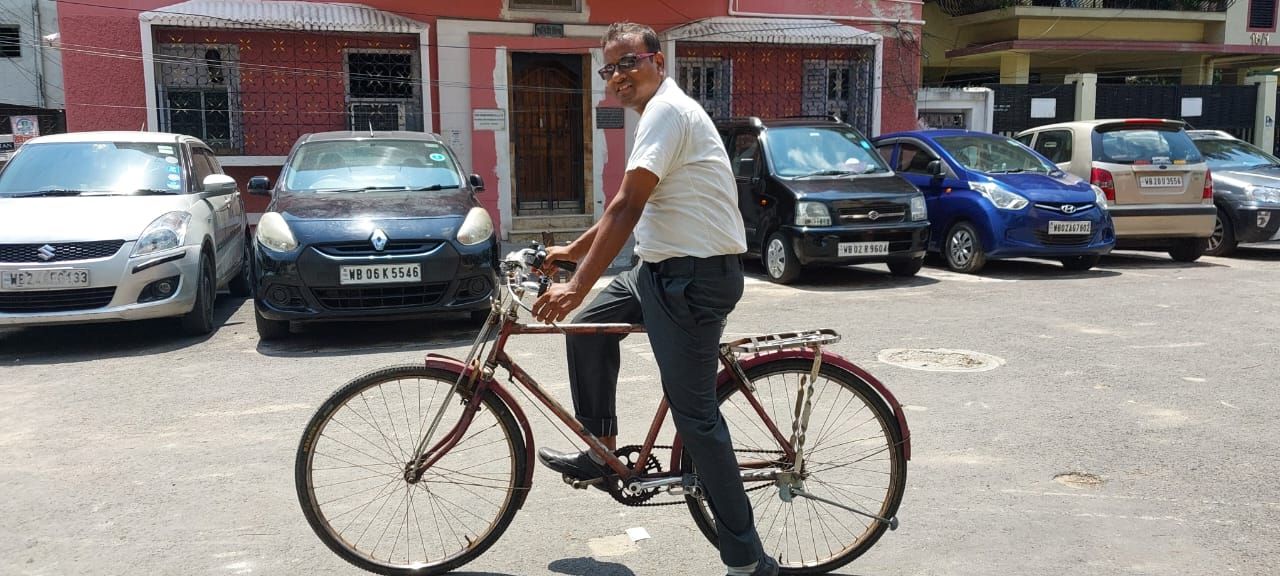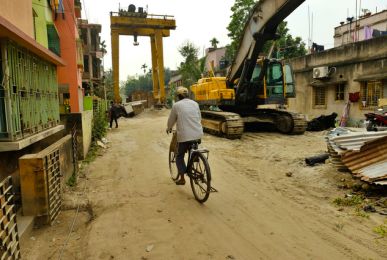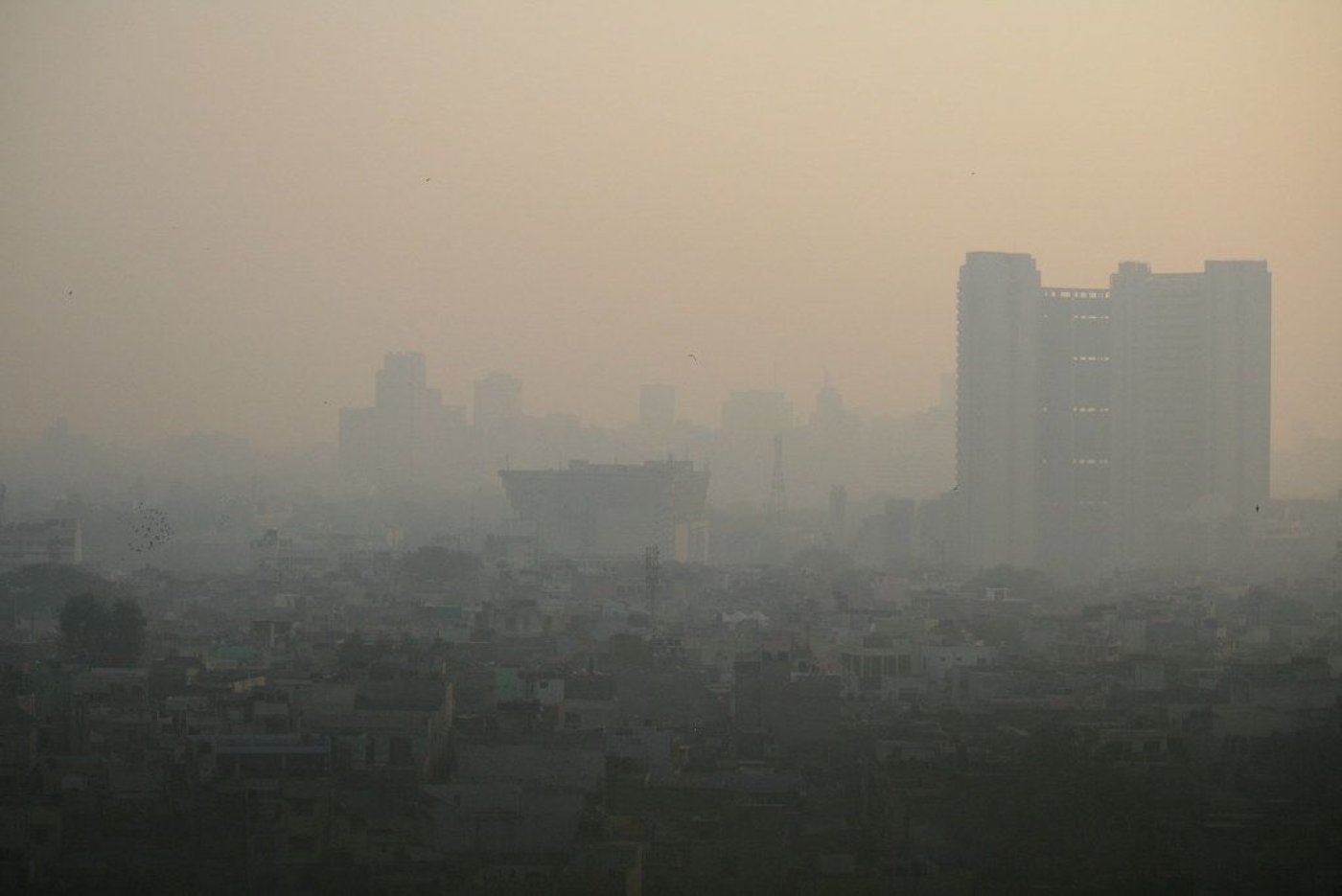Kolkata: It was 2016 when Prasanta Purkait, 43, a technician for a pest control company here in West Bengal’s capital, first experienced difficulty breathing. He noticed an uneasiness in his throat and a heavy feeling in his chest, the symptoms progressively worsening while a persistent cough would not subside despite medication.
Living in a densely populated South Kolkata locality near Gariahat police station, Purkait cycles about 10 km every day to different parts of Kolkata for work.
Over time, the city’s air pollution took a toll on his health, leading to a diagnosis of asthma and chronic obstructive pulmonary disease (COPD). As these conditions progressively damage his lungs and strain his heart, Purkait continues to cycle through the congested streets for his job.
"I have never smoked,” said Purkait. Doctors told him Kolkata's pollution was to blame. "I wear masks and gargle with warm water… but my symptoms become unbearable during the winter."
In November 2023, Kolkata’s air quality was in the ‘moderately polluted’ and ‘poor’ categories according to the National Air Quality Index run by the union ministry for environment, forests and climate change (MoEF&CC), which considers eight pollutants including particulate matter and noxious gases.
Kolkata’s AQI levels hovered between 195 and 271 in the winter of 2023, crossing 300 in January 2024. As per AirNow, following the U.S. Environmental Protection Agency index, an AQI over 100 is considered "unhealthy for sensitive groups," while 151-200 is "unhealthy" for the general public and poses increased risks for sensitive groups.
Levels between 201-300 are "very unhealthy," with heightened health risks for everyone. AQI exceeding 301 is labelled "hazardous," indicating emergency health conditions affecting everyone.
During this period, Kolkata's PM 2.5 level, which measures inhalable particulate matter or dust particles of diameters below 2.5 micrometres or microns, were up to 20 times higher than the WHO’s safe limit.
Particulate matter that falls within the PM 2.5 category are very fine particles, about 30 times thinner than the width of a human hair, which, when inhaled, penetrate deep into the lungs and are associated with a variety of respiratory and cardiovascular failures.
A 2010 study by the Chittaranjan National Cancer Institute, the West Bengal Department of Environment, and the Central Pollution Control Board (CPCB) found that about 70% of Kolkata's residents suffer from respiratory disorders due to air pollution.
"When I struggle with my COPD flares, I cannot sleep at night,” Purkait said, struggling for breath as he spoke. “I feel like I am dying."
Purkait's medical expenses have increased, with inhalers becoming a lifeline. The unhygienic conditions and lack of ventilation in the settlement where he lives, one of the regions in South Kolkata with a poor air quality index (AQI), worsen his health.

Over 800 Million At Risk Of Dying Earlier
Delhi, the world’s most polluted capital city, sees PM 2.5 levels soaring 100 times above WHO limits during peak winter months. From October to February, Delhi’s air quality fluctuates between ‘very poor’ and ‘severe’, while from March to May, it remains in the ‘poor’ category.
India is home to 42 of the world's top 50 most polluted cities. Whether ruled by parties that constitute India’s political opposition or by the ruling Bharatiya Janata Party (BJP), 1.3 billion Indians live in areas where the annual average particulate pollution level exceeds the WHO’s guideline of 5μg/m3 (microns per cubic metre) by 16 times.
More than two-thirds of the population, or 876 million people, more than the population of the United States and Canada combined, live in areas where air pollution exceeds India’s own national air quality standard of 40 µg/m3, which shaves 5.3 years off the life of the average Indian.
While air pollution remained absent from political discourse during the recently concluded 45-day general elections to the Lok Sabha, the 2024 State Of Global Air Report, a work of collaborative research by the US-based Health Effects Institute and Institute for Health Metrics and Evaluation, gives the Modi 3.0 government a clear and urgent agenda to address air pollution and its health impacts.
With their billion-plus populations, India and China together accounted for 54% of the total global disease burden from air pollution-related ailments in 2021; and the same year, nearly 50% of all ozone-related COPD deaths in the world were in India, according to the report.
The study pegged pollution-related deaths among children under five in India in 2021 at 169,400 deaths, the highest in the world, followed by Nigeria and Pakistan.
“Increasingly, rising temperatures are worsening air pollution and its health effects,” the report said, underscoring the need for urgent and integrated action on improving air quality and cutting greenhouse gas emissions. “Pollution undercuts health, stability, and productivity from individuals and families up to entire societies, nations, and regions.”
‘Year-Round Measures Needed’
Air quality improvement or environmental issues are not yet a priority in India, said Abhijit Chatterjee of Bose Institute, an interdisciplinary research centre in Kolkata, also an advisor to the National Clean Air Programme (NCAP), an MoEF&CC project.
“If you don't get water for four days, there is outrage,” said Chatterjee. “But have you ever protested about the quality of the air you breathe?”
Chatterjee said clean air, unlike drinking water, was not a voting issue because it was not visible. Residents in Delhi, particularly those with jobs that required exposure to the outdoors, echoed similar concerns.
A 30-year-old reporter in the capital city said her coughing and breathlessness fade away when she leaves the city. "Half of the winter, I'm either coughing or sneezing," she said, requesting that her name not be used. A post-Covid bout of bronchitis has meant that her condition is easily triggered by pollution and dust.
In 2019, for the first time, both the BJP and the Congress included in their election manifestos promises to address air pollution. The BJP promised to completely eliminate crop residue burning, and to develop advanced technologies and devices for better pollution monitoring in major cities.
The BJP’s manifesto also announced the relaunch of the NCAP as a mission to reduce air pollution in the country’s most polluted 131 cities, with a goal to reduce pollution levels in each of these cities by at least 35% over the next five years.
Delhi’s ruling Aam Aadmi Party (AAP), in its 2019 manifesto, promised measures such as the odd-even number plate scheme for vehicles and the graded response action plan (GRAP) during winter, citing Delhi’s non-statehood status as a limitation to implementing comprehensive pollution control measures.
Full statehood would allow them to introduce 100% electric buses in Delhi, vacuum cleaning of roads within a year, and enforcement of stringent rules for construction sites, the manifesto said.
Air quality improvement measures are largely seen as stopgap arrangements, said Keshav Suryanarayanan, deputy manager at ITDP India, which represents the Institute of Transportation and Development Policy (ITDP), a global non-profit organisation that works with cities worldwide to design transport systems that, among other things, reduce pollution.
"Measures to improve air quality need to be permanent and implemented year-round. Because pollution is permanent, the solutions should be too,” said Suryanarayanan. Winter smog becomes a concern because of its visibility, he said, “but the air is toxic all year round".
The Stubble-Burning Threat
The union government has said that a central sector scheme for promotion of mechanisation for in-situ management of crop residue in Punjab, Haryana, Uttar Pradesh and the national capital territory of Delhi promotes use of machines to clear post-harvest fields with a 50% subsidy to individual farmers and 80% subsidy for establishments.
The schemes for crop residue management are aimed at reducing pollution from stubble burning.
In 2023, the BJP government in Haryana also announced a paddy stubble management policy, aiming to utilise paddy straw left over on the field post-harvest for generation of sustainable energy. The policy aims to completely curb crop residue burning practices by 2027. Similarly, the Punjab government has promised to manage all 19.5 million tonnes of paddy straw in the state post-harvest, to prevent air pollution from crop residue burning.
Between 2018 and 2022, the centre released funds totalling Rs 2,440.07 crore to these states, through which more than 200,000 machines to clear crop residue have been delivered to individual farmers and groups.
Despite these measures and notwithstanding reductions in emissions in recent years, stubble burning remains a contributor to Delhi's air pollution during peak pollution seasons. In 2023, between 15 September and 23 November, 55,725 farm fires were recorded across six states of Punjab, Haryana, Uttar Pradesh, Delhi, Rajasthan and Madhya Pradesh.
Ravi Kumar, 32, a small farmer from Punjab’s Ferozepur district, has elderly family members suffering from asthma. “I know stubble burning is harmful to health, but I don’t have the money to use machines to clear my field,” he told Article 14. “We don’t burn the stubble by choice.”
In response to AQI levels dipping in Delhi, the AAP, BJP and Congress have blamed one another (here, here, and here) for the worsening conditions.
The BJP has accused the Arvind Kejriwal-led AAP for air pollution in Delhi and stubble burning in Punjab, while AAP has pointed fingers at the Haryana and Uttar Pradesh governments for not taking steps to address the issue.
Experts and environmentalists said resolving the air pollution crisis would need a coordinated approach among state and central governments.
“Addressing air pollution cannot solely be a state agenda, as national-level policies play a pivotal role,” said Naba Dutta, general secretary of Sabuj Mancha, a platform of environmental groups.
Promit Mookherjee, a researcher at the think tank Observer Research Foundation (ORF), said India needed a framework to bring different state governments together by establishing regional task forces or groups to formulate policies collaboratively.
“The challenge lies in coordinating efforts between states, as the political will required to prioritise air pollution varies,” said Mookherjee. Unlike Delhi, where air pollution is a pressing issue, states such as Punjab or Uttar Pradesh may not prioritise it, he said.
Fixing The National Plan For Better Air
The flagship National Clean Air Programme (NCAP), outlined in the BJP's 2019 manifesto, was launched in January 2019 to reduce particulate pollution of key pollutants PM 10 and PM 2.5 by 20%-30% in 131 cities by 2024.
In September 2022, this target was revised to a 40% reduction by 2026.
Multiple independent studies showed how the NCAP’s targets and methods require updating.
A 2024 analysis by the think tank Climate Trends revealed mixed results for NCAP, showing that 17 cities had witnessed improvements while others experienced worsening air quality.
While cities such as Kanpur, Meerut, and Lucknow met the NCAP targets, all of India’s 13 least polluted cities in 2023 still exceeded the WHO's limit of 5 µg/m³, which underscores the challenges in achieving internationally recognised air quality standards.
Meanwhile, despite the NCAP’s focus on better monitoring and mitigation measures, air pollution levels in major Indian cities including Delhi, Patna, Kolkata and Mumbai remained mostly unchanged or worsened during the winter months of 2023 compared to 2022, according to data.

Delhi reported the highest PM2.5 levels at 102 µg/m³ in 2023, a 2.5% increase from 2022. Patna recorded the highest PM10 levels in 2023, at 212.1 µg/m³, a 5.8% worsening from its 2019 levels.
Uttar Pradesh’s Varanasi city, with a population of 1.78 million, saw a 72% reduction in PM 2.5 and a 69% decrease in PM 10, according to official data. However, independent monitors still flag Varanasi’s air quality as ‘unhealthy’.
Cities such as Navi Mumbai, Ujjain, and Mumbai observed a rise in PM 2.5 levels, possibly due to an increase in active monitors as well as extended monitoring time. For PM10, Durgapur, Thane, and Mumbai showed an increase of 53%, 46% and 36%, respectively.
A 2024 article in Health Policy Watch, an online news outlet, highlighted that by the end of 2023, more than half of the funding allocated for the NCAP remained unused.
Compliance with the National Ambient Air Quality Standards and the clean air targets under the NCAP requires extensive air quality monitoring. However, a 2023 study by the Centre for Science and Environment (CSE) revealed that only 12% of India’s 4,041 census cities and towns have such monitoring systems, and just 200 cities monitor all six key pollutant criteria.
A major challenge with the implementation of NCAP is that it lacks legal enforcement. “It serves more as a guideline for the government rather than a mandated requirement,” Mookherjee said. Scorecards maintained under the programme offer a measure of accountability but there is no legal obligation for compliance.
Ending The Rural-Urban Divide
The programme’s urban-centric focus also neglects rural areas and non-NCAP cities, which also face significant pollution. “Air pollution is not restricted to cities,” Chatterjee said, adding that addressing this problem would require a regional ‘airshed’ management approach, which monitors pollutants concentrated in given areas not limited to conventional city or district boundaries.
In 2023, union minister of state for environment, forests and climate change Ashwini Kumar Choubey told Parliament that an IIT-Delhi study to delineate India’s major airsheds based on satellite data had found eight to nine major airsheds of “varying geographic coverage”, such as one or two over the Indo-Gangetic Plain, two to three smaller airsheds in north-eastern India, etc. Sector-wise recommendations had been made by a committee regarding an airshed-based approach, he said.
Even five years since its launch, the NCAP lacks a roadmap for defining airsheds and developing cross-jurisdictional monitoring processes needed for effectively implementing airshed-based air quality management.
Mookherjee and others said cities should streamline their efforts to harmonise different departments’ goals and measures on decarbonisation and air quality instead of permitting overlaps and inefficiencies. “For instance, while pollution control boards monitor air quality, they lack the authority to implement necessary policy changes,” he said.
Another challenge impeding the effectiveness of the clean air programme is that it operates alongside various decarbonisation initiatives, without integration.
"It’s important to align NCAP with broader decarbonisation efforts such as the electric vehicles (EV) policy to make it more effective," said Mookherjee.
Defining A Roadmap For Cleaner Air
In their 2024 manifesto, the BJP reiterated its commitment to the NCAP without setting any specific action plan to improve its mixed outcomes until now. It said, “Further, we will ensure that the NCAP effectively achieves and maintains the designated annual average ambient air quality standards in all regions of the nation…”
The Congress manifesto similarly promised to “strengthen” the NCAP “to urgently tackle” the problem of air pollution, but failed to offer a roadmap.
Strengthening the NCAP will require concerted, year-long, actionable solutions, improving enforcement and requiring accountability from pollution control boards, said experts.
Addressing and acting on pollution at the local level will be a first step. Chatterjee gave the example of Kolkata, where construction dust, solid waste burning, and biomass burning have emerged as more substantial pollution sources compared to vehicular emissions. “It is crucial to prioritise and manage these sources here,” he said.
Investing in public transport is another essential, urgent step for cleaner air. “Reliable, convenient, and high-quality public transport systems can incentivise people to shift away from personal vehicles,” said Suryanarayanan. That will require policies that simultaneously promote sustainable transport and renewable energy.
(Arunima Kar is an independent journalist based in Kolkata. She writes on the climate crisis, gender and health.)
Get exclusive access to new databases, expert analyses, weekly newsletters, book excerpts and new ideas on democracy, law and society in India. Subscribe to Article 14.

